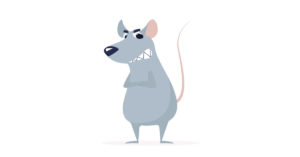
 Rats have a terrible reputation in language and literature. Think about the common phrases we use that mention them…
Rats have a terrible reputation in language and literature. Think about the common phrases we use that mention them…
“You dirty rat!”
“Rat someone out.”
“…like rats leaving a sinking ship.”
“I smell a rat!”
“…look like a drowned rat.”
People hate being in the “rat race.” Even terms that are somewhat more neutral like “lab rat” and “mall rat” are not usually positive connotations. So why are rats the bad guys?
Pop Culture, Literature, and Rodents
Think about it – rats technically aren’t any worse than other rodents… especially mice, which are their closest relatives. Both are problems when causing an infestation. Both are health code violations for businesses. Both can make perfectly fine pets when domesticated.
Yet mice have Mickey Mouse, Angelina Ballerina, Stuart Little, Mighty Mouse, Jerry from Tom & Jerry, Mrs. Brisby from The Secret of N.I.M.H. (as opposed to the evil rat, Jenner), and all of the heroic mice from Redwall as cute pop culture icons.
Rats do have Splinter, a.k.a. Master Splinter, in Teenage Mutant Ninja Turtles and Remy from Ratatouille as positive models, but not much else. Even Rizzo from The Muppets (while a good rat) is frequently the butt of jokes about rats being undesirable. And, of course, the villain in The Great Mouse Detective is Professor Ratigan, and one of the villains in Redwall is a rat named Cluny the Scourge.
Why Are Some Animals Depicted as Villains?
Experts believe animals tend to be cast as either heroes or villains based on a mix of three factors – fear, the cuteness of the creature, and its earliest depiction in myths and fables (with the latter laying the groundwork for more modern tales). While there are exceptions, that does explain why spiders and snakes are also frequently depicted as villains too… whereas dogs, horses, etc. are usually shown as heroes or allies.
The fear aspect makes sense. Rats appear unnerving in large numbers. As Matthew Combs of Fordham University points out, even though both mice and rats will infest to steal food, the amount and methodology make a difference in how they’re perceived. Mice only eat 2-4 grams of food a day and leave small, generally round holes when they chew through packaging. In contrast, rats eat 30-50 grams and are more aggressive in getting at that food. They will take apart things done to keep them out and will rip apart the packaging.
Combs further points out that the appearance difference signals one as cute and the other as not so much. Mice have heads and ears that are large in proportion to their bodies, which often translates as being “cute” to humans. Rats, instead, have large bodies with small heads and ears, and their tails are not considered cute. City rats are also prone to have scabs and lose fur, which makes them look shabby or diseased.
Mice, Rats, and Mythology
The differing temperaments of rats and mice when cornered also plays into what triggers human fear and what is perceived as vicious versus courageous. A cornered rat is likely to attack. Rather than attacking, mice will run – ideally to find a hiding place – but in lieu of that will scamper defensively to avoid you.
Appearance and behavior differences most likely contributed to how rats were portrayed in the earliest stories as opposed to mice. Aesop’s fables have many brave mice. These tales illustrate how to defeat stronger foes, the importance of kindness, and that it is smart to avoid trivial fights. Similarly, in Panchatantra from India, mice rescue elephants. In Kalilah wa Dimnah, from the Middle East, mice befriend crows.
Ancient stories featuring rats alternate between good and bad depictions. The Biblical Old Testament lists rats as unclean and to be avoided. Groups of rats in ancient Greece and Rome were portents of joy and abundance. In Chinese astrology, those born under the year of the rat are considered to be cheerful, sociable, and outgoing.
While the ancient versions of rats are not all bad; here in the west, the Middle Ages and our view of rats probably helped to contribute to this bad reputation. Rats helped to spread the plague through fleas they carried and (while that was not well known back then) as people died, rats became more aggressive to find food for themselves… contributing to fear of them. The term “plague rat” is yet another derogatory term that has been used more lately.
Call the Rodent Experts at Arrow
If you have a rat or rodent problem, call in the professionals at Arrow Exterminating. The sooner you contact us the sooner we can help you live in a critter-free environment. To get started, contact Arrow Exterminating today.




